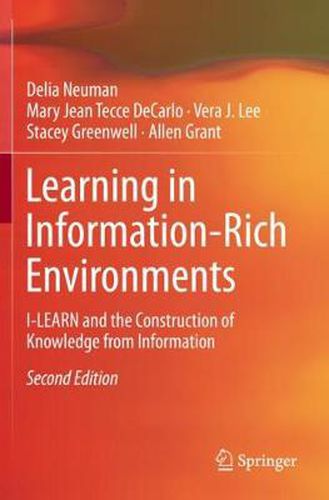Readings Newsletter
Become a Readings Member to make your shopping experience even easier.
Sign in or sign up for free!
You’re not far away from qualifying for FREE standard shipping within Australia
You’ve qualified for FREE standard shipping within Australia
The cart is loading…






This title is printed to order. This book may have been self-published. If so, we cannot guarantee the quality of the content. In the main most books will have gone through the editing process however some may not. We therefore suggest that you be aware of this before ordering this book. If in doubt check either the author or publisher’s details as we are unable to accept any returns unless they are faulty. Please contact us if you have any questions.
The amount and range of information available to today’s students-and indeed to all learners-is unprecedented. If the characteristics of the information age demand new conceptions of commerce, national security, and publishing-among other things-it is logical to assume that they carry implications for education as well. Little has been written, however, about how the specific affordances of these technologies-and the kinds of information they allow students to access and create-relate to the central purpose of education: learning. What does learning mean in an information-rich environment? What are its characteristics? What kinds of tasks should it involve? What concepts, strategies, attitudes, and skills do educators and students need to master if they are to learn effectively and efficiently in such an environment? How can researchers, theorists, and practitioners foster the well-founded and widespread development of such key elements of the learning process?
This second edition continues these discussions and suggests some tentative answers. Drawing primarily from research and theory in three distinct but related fields-learning theory, instructional systems design, and information studies-it presents a way to think about learning that responds directly to the actualities of a world brimming with information. The second edition also includes insights from digital and critical literacies and provides a combination of an updated research-and-theory base and a collection of instructional scenarios for helping teachers and librarians implement each step of the I-LEARN model. The book could be used in courses in teacher preparation, academic-librarian preparation, and school-librarian preparation.
$9.00 standard shipping within Australia
FREE standard shipping within Australia for orders over $100.00
Express & International shipping calculated at checkout
This title is printed to order. This book may have been self-published. If so, we cannot guarantee the quality of the content. In the main most books will have gone through the editing process however some may not. We therefore suggest that you be aware of this before ordering this book. If in doubt check either the author or publisher’s details as we are unable to accept any returns unless they are faulty. Please contact us if you have any questions.
The amount and range of information available to today’s students-and indeed to all learners-is unprecedented. If the characteristics of the information age demand new conceptions of commerce, national security, and publishing-among other things-it is logical to assume that they carry implications for education as well. Little has been written, however, about how the specific affordances of these technologies-and the kinds of information they allow students to access and create-relate to the central purpose of education: learning. What does learning mean in an information-rich environment? What are its characteristics? What kinds of tasks should it involve? What concepts, strategies, attitudes, and skills do educators and students need to master if they are to learn effectively and efficiently in such an environment? How can researchers, theorists, and practitioners foster the well-founded and widespread development of such key elements of the learning process?
This second edition continues these discussions and suggests some tentative answers. Drawing primarily from research and theory in three distinct but related fields-learning theory, instructional systems design, and information studies-it presents a way to think about learning that responds directly to the actualities of a world brimming with information. The second edition also includes insights from digital and critical literacies and provides a combination of an updated research-and-theory base and a collection of instructional scenarios for helping teachers and librarians implement each step of the I-LEARN model. The book could be used in courses in teacher preparation, academic-librarian preparation, and school-librarian preparation.